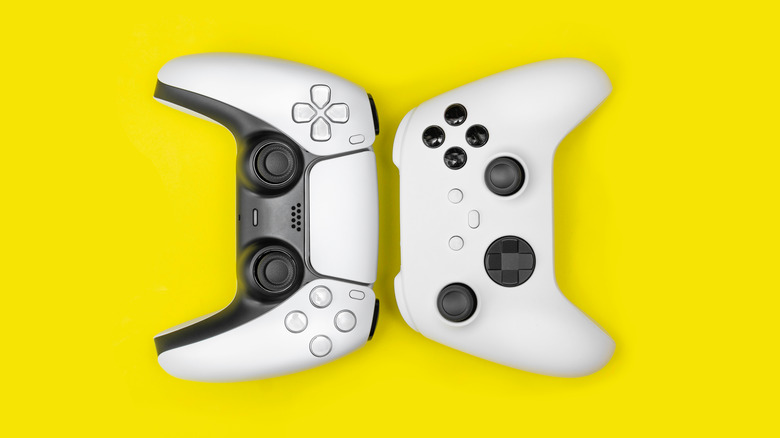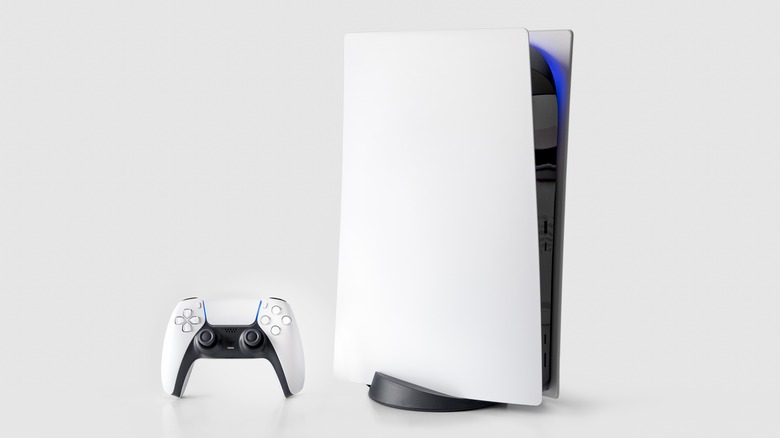How To Stream Games From Your Console To A PC
In the modern age, personal devices are more interconnected than ever before, communicating and sending data over local wireless networks to facilitate all kinds of new features. One surprising partnership that has arisen in this new ecosystem is the one between game consoles and PCs. Only a couple of decades ago, your game console would be a completely standalone device, reading data off of cartridges and minding its own business. These days, though, you can not only share data between your game console and your PC and PC-like devices like the Steam Deck but you can even use your PC as a medium for your game console.
Through the magic of remote play, you can mirror a game console's display to your PC, allowing you to enjoy your games from the comfort of your desk no matter how far your home office is from your living room. Most modern consoles are capable of making this connection happen, it just requires a bit of setting up and configuration, not to mention a steady internet connection.
What consoles can you connect to your PC?
In the current generation of video game consoles, two of the big three developers offer consoles with remote play functionality. Those developers are Microsoft and Sony with the Xbox and PlayStation, respectively. If you're playing an Xbox One, Xbox Series X, or Xbox Series S, you can connect to your PC for remote play, while the same goes for both the PlayStation 4 and PlayStation 5. Both of these console families use their own account ecosystems and the setup processes are slightly different, but the overall result is the same.
The only outlier to the remote play bandwagon is the Nintendo Switch. The Switch, unfortunately, does not feature any kind of connectivity with PCs or remote play functionality. There is no way to play your Nintendo Switch games but on a Nintendo Switch console. The only real extra-device functionality the console has is the Nintendo Switch Online mobile app, which only offers a few extra features in games like "Splatoon 3" and "Animal Crossing: New Horizons."
Connecting your Xbox to your PC
Since both Xbox consoles and the Windows operating system are made by Microsoft, remote play between the two is designed to be fairly straightforward. As long as you have a Microsoft account, you can start a session on your Xbox, and then carry it over to your PC via the Xbox PC app.
Here's how to set up remote play functionality on an Xbox console. Note that this process is the same for both Xbox One and Xbox Series X/S consoles.
-
On your Xbox console, press and hold the Xbox button on your controller to bring up the menu.
-
Select Profile & System.
-
Select Settings.
-
Select Devices & connections.
-
Select Remote features.
-
Activate the Enable remote features checkbox.
-
Return to the main menu and select Power options.
-
Select Sleep to put the console to sleep.
-
On a Windows PC on the same internet connection, launch and log into the Xbox app.
-
Click on your profile picture and select View profile.
-
In the Where I play section, select Add a console and follow the displayed steps to add your Xbox.
Once your Xbox is added to your PC Xbox app, click the three dots next to it to remotely activate it and access its game library. The only extra condition here is that you need to have an Xbox-compatible controller either connected or synced to your PC to remote-play games.
Setting up your PlayStation for your PC
Sony and Microsoft may be long-standing rivals in the gaming scene, but even PlayStation developers know that PC gamers want a piece of the action, and they're happy to provide it with remote play. The process is a bit more involved since PlayStations aren't explicitly built with PC connectivity in mind like Xboxes, but it's still very possible.
The initial setup process is slightly different between the PS4 and PS5, though starting remote play is the same.
Here's how to set up your PS4 for remote play.
-
On the function screen, select Settings.
-
Select Remote Play Connection Settings.
-
Activate the Enable Remote Play toggle.
-
Return to Settings and select Account Management.
-
Select Activate as your Primary PS4 and confirm.
-
Return to Settings and select Power Save Settings.
-
Select Set Features Available in Rest Mode.
-
Enable Stay Connected to the Internet and Enable Turning on PS4 from Network.
Here's how to set up a PS5 for remote play.
-
From the home screen, go to Settings.
-
Select System.
-
Select Remote Play.
-
Activate the Enable Remote Play toggle.
-
Return to the System menu and select Power Saving.
-
Select Features Available in Rest Mode.
-
Enable both Stay Connected to the Internet and Enable Turning on PS5 from Network.
Connecting your PlayStation to your PC
Before you can connect your PlayStation to your PC, you'll need to download and install the PS Remote Play app on your PC, as well as have an active PSN account you can log into. You'll also need either a DualSense or DualShock controller connected to your PC or synced with Bluetooth. Once you've met all the requirements, you can make the connection on your PC.
-
Turn on your PlayStation console.
-
Place your PlayStation console in rest mode.
-
Connect your controller to your PC.
-
Launch the PS Remote Play app.
-
Sign in with your PSN account. It must be the same account you use on your PlayStation.
-
Select either PS4 or PS5.
-
The app will scan for a PS4/PS5 on the same internet connection and connect to it automatically.
-
If multiple PlayStation consoles are detected, select the one you want on your PC to connect to it.
After the app connects to the console, its display will appear on your PC, and you can control it as you normally would, accessing your game library and launching games.




